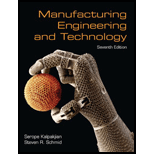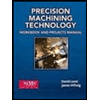
What is an abrasive? What are superabrasives?
What is an abrasive? What are superabrasives?
Explanation of Solution
Small, hard particle with sharp edges are abrasives. Irregular shaped sand is an example of it. It is used to remove small amounts of material from a particular surface. Hard material like diamond or cubic boron nitride (CBN) is used to prepare super abrasives. Rectification tools and also grinding wheels are made up of superabrasives.
Want to see more full solutions like this?
Chapter 26 Solutions
Manufacturing Engineering & Technology
Additional Engineering Textbook Solutions
Thermodynamics: An Engineering Approach
Machine Elements in Mechanical Design (6th Edition) (What's New in Trades & Technology)
Engineering Mechanics: Statics
Statics and Mechanics of Materials (5th Edition)
Fluid Mechanics: Fundamentals and Applications
Machine Tool Practices (10th Edition)
- Differentiate Between Gear Hobbing And Gear Shaping With Reference To Various Relative Motions And Applications?arrow_forwardWhat are the two forms of abrasives used in benchwork?arrow_forward(a) Figure 1 shows surface roughness and tolerances obtained in Chemical Machining (CM) and Electrochemical Machining (ECM) process for different types of electronic products. Comment on the differences between chemical and electrochemical machining process in terms of surface roughness and tolerance of the machined product as illustrated in Figure 1. 0.9 CM 0.8 0.7 Z ECM 0.6 0.5 0.4 0.3 0.2 0.1 Product A Product B Product C Product D Products 25 E ČM 20 Z ECM 15 10 Product A Product B Product C Product D Products Figure 1: Surface roughness and tolerances of various electronic products Surface roughness, Ra Tolerance, (t mm x 10)arrow_forward
- What is Tribology?arrow_forwardWhich three of the following are names given to the three regions in the typical wear growth curve: (Choose three answers) temperature region diffusion region failure region 0000000 accelerated wear region break-in period steady-state wear abrasion regionarrow_forwardSpeed of Ball Mill In a ball mill of diameter 2000 mm, 100 mm dia steel balls are being used for grinding. Presently, for the material being ground, the mill is run at 15 rpm. At what speed will the mill have to be run if the 100 mm balls are replaced by 50 mm balls, all the other conditions remaining the same?arrow_forward
- (a) Give three examples of applications where a solid lubricant would be preferable to aliquid lubricant. For each example, explain the advantages of using a solid lubricantand suggest one suitable candidate giving reasons for your suggestion. Support yourdiscussion by citing relevant sourcesarrow_forwardThe structure of a grinding wheel is defined as 1-A material that holds the abrasive grains together to form a grinding wheel 2-The density of the grains in wheel 3-Indicates the strength of the bond in the wheel 4-The size of the abrasive grains in the wheelarrow_forward5.a) Derive a quantitative relationship for abrasive wear b) Explain the merits and demerits of various theories of friction c) Discuss the four basic types of wear mechanismsarrow_forward
- The bond of a grinding wheel is defined as A material that holds the abrasive grains together to form a grinding wheel The density of the grains in wheel The size of the abrasive grains in the wheel Indicates the strength of the bond in the wheelarrow_forwardThe structure of a grinding wheel is defined as A material that holds the abrasive grains together to form a grinding wheel The density of the grains in wheel Indicates the strength of the bond in the wheel The size of the abrasive grains in the wheelarrow_forwardExplain Surface Roughness Including Below Given Roughness Parameters 1.Ra 2. Rtarrow_forward
 Precision Machining Technology (MindTap Course Li...Mechanical EngineeringISBN:9781285444543Author:Peter J. Hoffman, Eric S. Hopewell, Brian JanesPublisher:Cengage Learning
Precision Machining Technology (MindTap Course Li...Mechanical EngineeringISBN:9781285444543Author:Peter J. Hoffman, Eric S. Hopewell, Brian JanesPublisher:Cengage Learning
